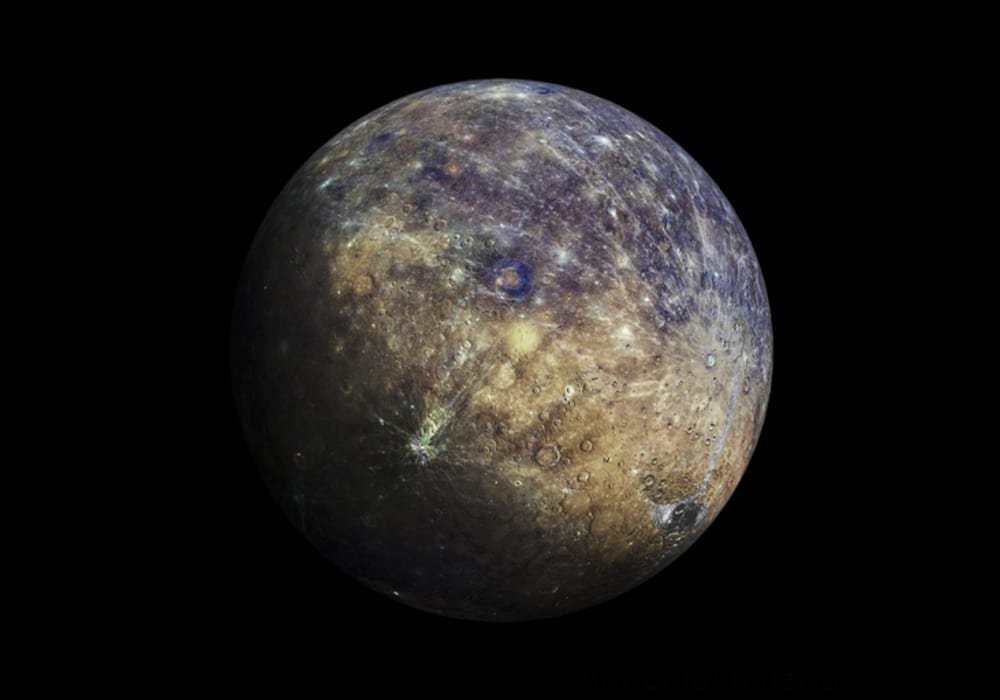Planet Mercury
Mercury is the closest planet to the Sun and the least massive in the Solar System. Its distance from the Sun is between 0.31 and 0.47 astronomical units (i.e. 46 and 70 million kilometers or 28,58 and 43,5 million miles ), which corresponds to an eccentricity orbital 0.2 – more than twelve times that of Earth, and by far the highest for a planet in the Solar System. It is visible to the naked eye from Earth with an apparent diameter of 4.5 to 13 arc seconds, and an apparent magnitude of 5.7 to −2.3; its observation is however made difficult by its elongation always less than 28.3 ° which most often drowns it in the radiance of the sun. In practice, this proximity to the sun implies that it can only be seen near the western horizon after sunset or near the eastern horizon before sunrise, usually at dusk. Mercury has the particularity of being in a 3: 2 spin-orbit resonance, its period of revolution (~ 88 days) being exactly 1.5 times its period of rotation (~ 59 days), and therefore half of a solar day (~ 176 days). Thus, relative to fixed stars, it rotates on its axis exactly three times every two revolutions around the Sun.
Mercury is a terrestrial planet, as are also Venus, Earth and Mars. It is nearly three times smaller and almost twenty times less massive than Earth but almost as dense as it is. Its remarkable density – exceeded only by that of the Earth, which would also be lower without the effect of gravitational compression – is due to the size of its metal core, which would represent 85% of its radius, against about 55 % for Earth.
Like Venus, Mercury is almost spherical – its flattening can be considered zero – due to its very slow rotation. Deprived of a real atmosphere to protect it from meteorites (there is only one exosphere exerting a ground pressure of less than 1 nPa or 10−14 atm), its surface is very strongly cratered and generally similar to the far side of the Moon, indicating that it has been geologically inactive for billions of years. This absence of atmosphere combined with the proximity of the Sun generates surface temperatures ranging from 90 K (−183 °C or -297,4 °F) at the bottom of the polar craters (where the Sun’s rays never reach) up to 700 K (427 °C or 800 °F) at the subsolar point at perihelion. The planet is also devoid of natural satellites.
Only two space probes have studied Mercury. Mariner 10, which flew three times the planet in 1974–1975, mapped 45% of its surface and discovered the existence of its magnetic field. The MESSENGER probe, after three overflights in 2008-2009, went into orbit around Mercury in March 2011 and carried out a detailed study, in particular of its topography, its geological history, its magnetic field and its exosphere. The BepiColombo probe aims to enter orbit around Mercury in December 2025.
The planet Mercury owes its name to the messenger of the gods in Roman mythology, Mercury. The planet is so named by the Romans because of the speed with which it moves in the sky. The astronomical symbol of Mercury is a circle placed on a cross and carrying a semicircle in the shape of horns (Unicode: ☿). It is a representation of the caduceus of the god Hermes, equivalent of Mercury in Greek mythology. Mercury also gave its name to the third day of the week, Wednesday (“Mercurii dies”).
The conquest of Mercury
In 1974, Mariner 10, a space probe developed by NASA, was launched to study Mercury. It was the first time that man could observe the surface of this mysterious planet. The probe returned a large number of pictures, revealing a strange surface riddled with craters and mountains, as well as a weak magnetic field.
Since 2011, another probe sent by NASA, Messenger, has produced detailed mapping of the surface of Mercury. We now know that Mercury was once invaded by volcanoes, but there is still a lot of mystery around this planet.
Scientists are trying to understand the nature of the planet, what matter it is made of, and how its magnetic field works. They also want to study interactions with the Sun, because it is extremely close to it. All of this represents very good reasons to continue to send probes there.
Bepicolombo
In October 2018, Europe launched its own mission to Mercury, called Bepicolombo, in homage to the Italian mathematician whose calculations made it possible to trace the trajectory of Mariner 10. His first challenge will be to successfully cling to the gravitational force of Mercury and to avoid falling into the Sun, whose force of attraction is simply phenomenal. This first challenge will require great caution and a great deal of energy. To reach Mercury, the probe will need 6 years, and as much energy as if we were to go to Pluto!
Bepicolombo wants to be the most complete mission ever carried out towards Mercury. It is a project carried out in collaboration with the Japanese space agency. The project takes the form of two probes, each with a very specific set of tasks to perform.
The Bepicolombo project consists of two orbiters, one from Europe (the planetary orbiter) and the other from Japan (the magnetospheric orbiter). The planetary orbiter is designed to observe plasma all around Mercury using a host of imaging instruments and spectrometers. The magnetospheric orbiter, on the other hand, is responsible for mapping the magnetosphere and the plasma. This orbiter will operate at a much higher altitude than the other orbiter.
It is a one-year mission that will analyze the internal structure, geology and magnetic field of Mercury. It is at high risk for the probes, as they will have to face the fierce heat of the Sun, just like the radiation reflected by Mercury. In order to protect itself, the probe is equipped with radiators and thermal shields, to maintain an operating temperature.
The planetary orbiter will revolve around Mercury, and all of its instruments will be aimed at the planet’s surface. This means that almost all of the orbiter’s instruments will have high exposure to solar radiation, and this presents a great technical challenge. Only a “cold” side of the probe will be directed into space. This is the part of the probe that will carry the radiator and allow the excessive heat produced by the probe to be rejected.
It is expected that Bepicolombo will reach Mercury in 2025. This is a very important mission, because besides the fact that it will allow us to know Mercury better, it will also help us to better understand how the other terrestrial planets of the solar system were formed. . And it could also give information about other exotelluric planets.
Mysteries to be unraveled
A large number of astronomers have been studying the formation of exoplanets (planets outside our solar system orbiting a star) in recent years. Like Mercury, a large number of these planets evolve close to their star. Studying Mercury will therefore allow us to understand a lot of things about exoplanets, in particular how they were formed and why they are so close to their star.
Scientists around the world are wondering how Mercury’s orbit and rotation could have changed over time. That’s a question they can’t wait to answer, as it seems other planets near their star behave the same. Understanding the interaction between the Sun and Mercury will therefore allow us to partly understand the interaction between a star and its nearest planet.
There is a good theory that explains the formation of planetary systems. It is based on the formation of our solar system. But what is true for our solar system is not necessarily true for other systems. Mercury represents a special case for scientists, so we need to understand how it formed and evolved to understand how planets form and evolve outside our solar system.
Water on Mercury
The Messenger probe revealed that water existed on Mercury in the form of ice. Despite the extremely high temperature on Mercury, there are some dark regions that never see sunlight. And it is in these regions that we have seen the existence of solid water. It is probable that this water was brought by comets. Analyzes from the Messenger probe show that this water ice is covered with a dark carbonaceous element. These are the same elements that participated in the emergence of life on Earth! The Messenger probe crashed into Mercury on April 30, 2015 (voluntary maneuver).
Questions about Mercury
Why is it hotter on Venus than on Mercury?
Mercury being closer to the Sun than Venus, one would think it is much warmer there. It’s quite the opposite. The average temperature on Mercury is 160 °C, while it is 462 °C on Venus. The explanation is that Mercury does not have an atmosphere, so it has no way of storing heat. All the heat it receives disappears into space.
Venus has a strong atmosphere that stores heat through a greenhouse effect due to its high rate of carbon dioxide. The heat of the Sun is therefore trapped there, and the consequence is that it is much hotter there than on Mercury.
Can we observe Mercury?
Mercury is visible to the naked eye and it has been spotted for thousands of years. But it is very difficult to observe because of its small size and its proximity to the Sun. Even though it is (difficult) to observe it with a telescope, very little detail is visible, so observing Mercury from Earth is of little interest. When it is in alignment with the Earth and the Sun, it can be observed using a solar filter. It then appears as a perfect disk in front of the Sun.
Is there daylight on Mercury?
If we could tread the soil of Mercury, we would see the same thing as on the Moon: the sky is completely black, because no atmosphere is present to diffuse the light of the Sun. On Mercury, the night is eternal.
Why are there so many craters on Mercury?
Like any other planet in the solar system, Mercury has seen the ravages of asteroids of all kinds. But unlike the Earth, it is unprotected because it has no atmosphere. The Earth’s atmosphere largely disintegrates most of the meteorites that fall on us. In addition, the absence of an atmosphere on Mercury means that there is no erosion. Visible craters have been there for 4.5 billion years.
What is the biggest crater on Mercury?
The largest crater on Mercury is the Caloris Basin, which is around 1,500 km in diameter. The size of the asteroid that formed this crater is estimated to be 100 km wide. Immediately after the impact, the seismic waves converged on the other side of the planet, causing the surface to tear. This gave rise to some amazing rock formations, a real chaotic terrain. The craters transformed into hills 10 km wide and two km high in a matter of seconds. It is not known exactly when this immense impact took place. It is believed to be just under four billion years old. But what is certain is that if Earth were to take an impact of this size, it would wipe out humanity.
Astrology: Mercury for Gemini and Virgo
Mercury is the planet of communication. We remember that the Roman god Mercury (or Hermes among the Greeks) is the messenger of the gods. This planet gives predispositions to exchange, sharing and determines the intellectual acuity of individuals. It can also illustrate a certain futility or superficiality. The Air element is associated with it.
When Mercury brings something positive, it is to accentuate sociability, enliven people with a sense of humor, and facilitate their communication skills.
On the other hand, when Mercury wants to be negative, it maintains relations without depth, palaver, the absence of sensitivity. It can also generate nervous and excessive tension.
Mercury is the planet of Gemini and Virgo, that is to say very cerebral people, animated by a certain intellectual curiosity but also versatile in their relationships with others.
Sources: PinterPandai, NASA Science, Space Facts, The Planets
Photo credit: Wikimedia Commons
Photo explanations: Mercury as imaged by the cameras on board the MESSENGER spacecraft of NASA.



